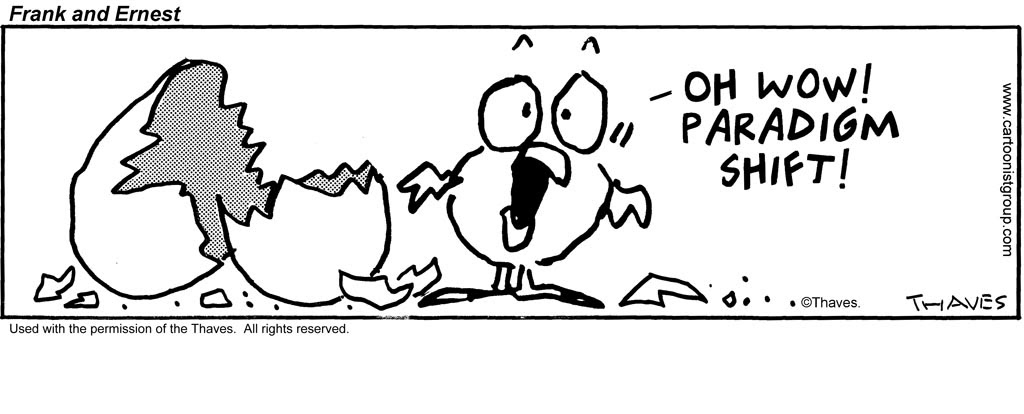Coram Deo is about living every moment of our lives before the face of God–in his presence, under his authority, and for his glory–whether in the sanctuary, in the home or in the marketplace and the public square.
That being the case, we have chosen the term Coram Deo for an exciting new training opportunity from the DNA. We have captured the DNA’s best teaching and carefully condensed it into a set of video presentations and readings. Organized into a 12-week interactive course with other students or a self-study at your own pace, this is the same teaching you would receive at a five-day Vision Conference, the DNA’s flagship training program.
This post is the second in a series of four that unpacks the biblical idea of Coram Deo. (The entire paper is available here.)
 The word coram is derived from the Latin cora, which means “the pupil of the eye.” It is translated “in person,” “face-to-face,” “in one’s presence,” “before one’s eyes,” “in the presence of,” “before.”[1] The second word, Deo, is the Latin word for God. The key idea in the phrase is intimate, personal relationship. In this case, God intimately knows me. Nothing is hidden. And I am to consciously seek to live all of my life in the presence of God—“before the face of God.” Some have used the concept of “the audience of one” to describe this lifestyle. Puritan pastor Cotton Mather (1663–1728) put it this way: “Let every Christian walk with God when he works at his calling, and act in his occupation with an eye to God, act as under the eye of God.”[2] Even the great English poet John Milton (1608–1674) captured the sense of living under the gaze of our Heavenly Employer: “All is, if I have grace to use it so, As ever in my great task-Master’s eye.”[3]
The word coram is derived from the Latin cora, which means “the pupil of the eye.” It is translated “in person,” “face-to-face,” “in one’s presence,” “before one’s eyes,” “in the presence of,” “before.”[1] The second word, Deo, is the Latin word for God. The key idea in the phrase is intimate, personal relationship. In this case, God intimately knows me. Nothing is hidden. And I am to consciously seek to live all of my life in the presence of God—“before the face of God.” Some have used the concept of “the audience of one” to describe this lifestyle. Puritan pastor Cotton Mather (1663–1728) put it this way: “Let every Christian walk with God when he works at his calling, and act in his occupation with an eye to God, act as under the eye of God.”[2] Even the great English poet John Milton (1608–1674) captured the sense of living under the gaze of our Heavenly Employer: “All is, if I have grace to use it so, As ever in my great task-Master’s eye.”[3]
Made for God’s Presence
What these Christians who walked before us recognized was that humans were made to walk in God’s presence. From Genesis to Revelation, God reveals himself as the “Infinite-Personal God,” to use Francis Schaeffer’s term. In Genesis 1:26, God reveals not only that he is the Personal God but also that he is Community: “Let us make man in our image, in our likeness.” Before the creation of the world there was the intimacy of communion and communication between the Persons of the Trinity—the One and Many God.
God made man is his image so that man might have relationship with his own kind (other humans) and also to have communion with his Creator. The intimacy of God’s intention is found in Genesis 3:8–9: “Then the man and his wife heard the sound of the Lord God as he was walking in the garden in the cool of the day, and they hid from the Lord God among the trees of the garden. But the Lord God called to the man, ‘Where are you?’”
This same sense of communion is found in the wilderness wanderings when God instructs Moses to build a tent for him so the presence of the transcendent God may dwell in the midst of the Hebrew camp. The Hebrews were living in tents, and God so desired to identify with his people that he wanted to “tabernacle”—live in a tent—just like his people. “Then have them make a sanctuary for me, and I will dwell among them. Make this tabernacle and all its furnishings exactly like the pattern I will show you” (Exod. 25:8–9).
Perhaps the most remarkable demonstration that God’s intention is to have humans dwell in his presence is that he chose to enter history as a vulnerable baby. The Incarnation marks the high point of God’s communion with man in that the Son of God became the Man, Christ Jesus. Young’s Literal Translation of the Bible captures the thrill of the intimacy of the Incarnation in John 1:14: “And the Word became flesh, and did tabernacle among us, and we beheld his glory, glory as of an only begotten of a father, full of grace and truth.”[4]
The Greek word used for “tabernacle” in Exodus 25:8–9 in the Septuagint (the Greek translation of the Old Testament), skenoo, is the same word used in John 1:14. It means “to fix one’s tabernacle, have one’s tabernacle, abide (or live) in a tabernacle (or tent), tabernacle” or “to dwell.”[5] This is a powerful image of God’s desire and intentions for us to dwell in his presence, “before the face of God.”
God continues to take the initiative and offers to restore intimacy with us through his Son, Jesus Christ. The apostle Paul writes, “Once you were alienated from God and were enemies in your minds because of your evil behavior. But now he has reconciled you by Christ’s physical body through death to present you holy in his sight, without blemish and free from accusation—if you continue in your faith, established and firm, not moved from the hope held out in the gospel” (Col. 1:21–23). In redemption as in creation, we find that God desires for his people to dwell in his presence.
Work as Worship
One of the primary themes of the Reformation was that we are justified by faith and we are to live by faith, before the face of God. The apostle Paul writes of our justification by faith clearly in Ephesians 2:8–9: “For it is by grace you have been saved, through faith—and this not from yourselves, it is the gift of God—not by works, so that no one can boast.” When we come to God, we come in faith—with empty hands. Good works will not save us. Rather we stand directly before God only by his grace, through faith in the only intermediary, Jesus Christ.[6]
Just as in salvation we stand before God by faith, Scripture witnesses that we are to live daily before God in faith. Once dead, we are now alive in Christ. Paul writes of this throughout his letters, perhaps nowhere as clearly as in Galatians: “I have been crucified with Christ and I no longer live, but Christ lives in me. The life I live in the body, I live by faith in the Son of God, who loved me and gave himself for me” (Gal. 2:20). Truly those “who receive God’s abundant provision of grace and of the gift of righteousness [will] reign in life through the one man, Jesus Christ” (Rom. 5:17).
For Christians who understand that we are saved by grace through faith, the whole concept of work has been transformed to that of worship. Paul told the Roman believers, “Therefore, I urge you, brothers [and sisters], in view of God’s mercy, to offer your bodies as living sacrifices, holy and pleasing to God—this is your spiritual act of worship” (Rom. 12:1; italics added). Scottish historian and social critic Thomas Carlyle (1795–1881) has captured the wonder of what our forefathers understood: Laborare est Orare, Work is Worship. . . . All true Work is sacred; in all true Work, were it but hand-labour, there is something of divines. . . . No man has work, or can work, except religiously; not even the poor day laborer, the weaver of your coat, the sewer of your shoes.[7]
In 1520 Martin Luther published a short work called The Babylonian Captivity of the Church. As this tract began to circulate around Europe, it resulted in a firestorm that transformed entire cultures’ thinking on life and work. An anonymous story is told about two priests who read the pamphlet when it reached Holland. The following is part of what they read that so changed their way of thinking:
The works of monks and priests, however holy and arduous they be, do not differ one whit in the sight of God from the works of the rustic laborer in the field or the woman going about her household tasks, but that all works are measured before God by faith alone. . . . Indeed, the menial housework of a manservant or maidservant is often more acceptable to God than all the fastings and other works of a monk or priest, because the monk or priest lacks faith.[8]
This tract challenged the two priests about the nature of salvation, the nature of the church, and the nature of work. Up to that point, their church had been open to the parish seven days a week. After reading the pamphlet, they announced that the doors of the church building would be opened on Sunday but closed the rest of the week.
That was a shocking change. What could they have been thinking? Through Luther’s writings, the priests had come to see that the work their parishioners did six days a week was no less sacred than the work they themselves did, that is, if each worked in faith. They understood that people did not need to visit the church building daily to do their “spiritual” service or to add a measure of holiness to their days. Both the clergy and the “laity” were to live every day of the week, every hour of the day, in all they did, coram Deo, before the face of God. Both those laboring in the community’s church and those laboring in the community’s fields, houses, and shops had the potential to worship God in their work. It was not the nature of one’s work but the faith with which one worked that mattered.
– Scott Allen and Darrow Miller
Adapted from LifeWork: A Biblical Theology for What You Do Every Day, chapter five “Coram Deo: Before the Face of God” pp. 55-68. Copyright © 2009 by Darrow L. Miller, Published by YWAM Publishing, a ministry of Youth With A Mission, P.O. Box 55787, Seattle, WA 98155-0787. All rights reserved. No part of the book may be reproduced in any form without permission in writing from the publisher, except in the case of brief quotations in critical articles or reviews.
[1] William Whitaker, WORDS, s.v. “coram,” http://www.archives.nd.edu (accessed May 27, 2009).
[2] Cotton Mather, “A Christian at His Calling,” quoted in Ralph Barton Perry, Puritanism and Democracy (New York: Vanguard, 1944), 127, quoted in Leland Ryken, Redeeming the Time (Grand Rapids: Baker Books, 1995), 106.
[3] John Milton quoted in Leland Ryken, Worldly Saints: The Puritans As They Really Were (Grand Rapids: Zondervan, 1990), 28.
[4] Robert Young, Young’s Literal Translation (Oak Harbor, WA: Logos Research Systems, 1997), S. Jn. 1:14.
[5] Enhanced Strong’s Lexicon, s.v. “skenoo.”
[6] 1 John 2:1.
[7] Thomas Carlyle, Past and Present (1842; Project Gutenberg, 1996), www.gutenberg.org/files (accessed May 27, 2009).
[8] Martin Luther, The Babylonian Captivity of the Church (1520; Project Wittenberg Online Electronic Study Edition, 2002, www.ctsfw.edu (accessed May 27, 2009).





